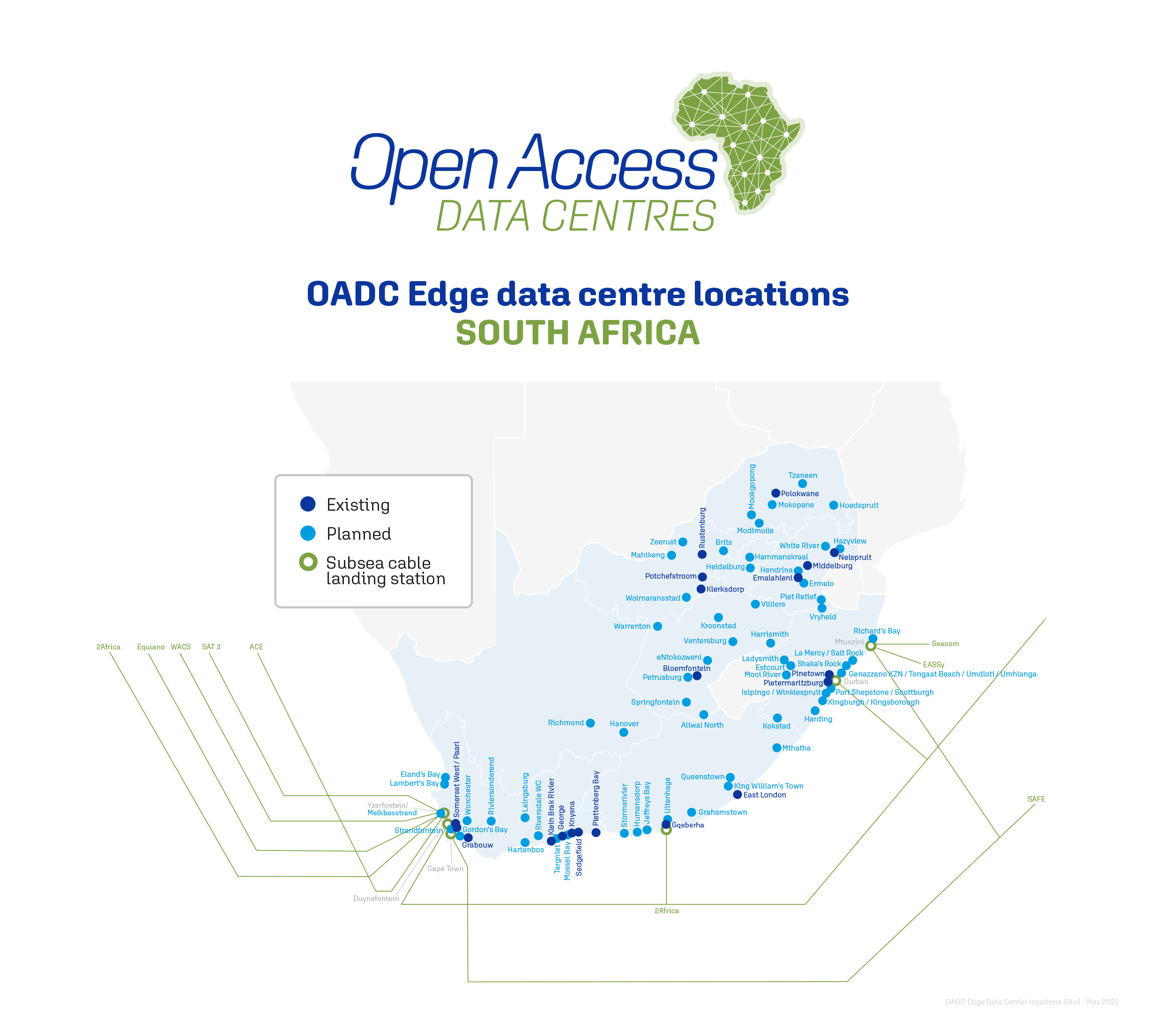Hyperscale Data Centres: Scale, Speed & Strategy
Hyperscale Data Centres: Scale, Speed & Strategy
Insights into Data Centre Investment & Market Growth
News
Scalable Network Attached Solutions for Modern Infrastructure
Infinidat advances partner portal and expands channel sales with STaaS
Infinidat has announced new moves to advance its strong position in partnering, supporting and co-selling with channel partners, accelerating adoption of storage-as-a-service (STaaS), and significantly enhancing partner sales enablement. Infinidat will roll out a new global version of its partner portal in July, rebuilt from the ground up, to train and equip solution providers worldwide to grow their revenue at a faster pace and deliver their customers true business and technical value with Infinidat’s platforms. In addition, the company announced that it has integrated Infinidat’s STaaS solution into Arrow Electronics’ ArrowSphere in North America.
“Our latest investments for our partners to have best-in-class tools and access to leading-edge ecosystems reflect our ongoing, strong commitment to our channel-centric model for go-to-market execution,” says Eric Herzog, CMO at Infinidat. “We’re streamlining and simplifying the partner experience to boost channel participation and success. We’re making it easier for solution providers to sell Infinidat’s industry acclaimed enterprise solution portfolio, including enhanced AIOps capabilities, industry-leading real world application performance with the lowest latency, and the rollout of our innovative InfiniSafe technology across our platforms for groundbreaking levels of cyber resilience, all with the choice of flexible consumption models.”
Partner portal gets a makeover
Infinidat has rebuilt its partner portal to deliver an enhanced experience for the channel. It is designed to catapult partners forward with dynamic and relevant information to enable competitive advantages. The new portal features the following:
Easier navigation to simplify use of the knowledgebase and enablement tools in the portal in support of new and expanding market opportunities.Refreshed, modernised, and expanded content, including detailed information about the new InfiniSafe technology on InfiniBox and InfiniGuard. In addition, localised content in different languages for its global partner ecosystem.Streamlined training experience to make partners more technically adept to sell Infinidat’s portfolio for mutual benefits. Accreditation, also, continues to be part of the program.
“We have been a strong partner of Infinidat for several years, and their partner support, programs, and portal have been top-notch,” says Jan Veith, Sales Director, Hansen & Gieraths IT Solutions GmbH. “We are very excited about the new, streamlined Infinidat partner portal and how it will help us grow our business, deliver better solutions leveraging Infinidat’s award-winning platforms, and keep our teams up-to-date on all things Infinidat.”
Infinidat has worked with third-party vendors to bring state-of-the-art capabilities into its new portal for channel partners. One of them is Highspot, the sales enablement platform that increases the performance of sales teams by bridging the gap between strategy and execution.
“We’re proud that Infinidat has chosen Highspot's sales enablement platform to deliver the right resources to their channel partners at the right time within their new partner portal,” says Gwen Sheridan, Vice President of Customer Services, Highspot. “With Highspot, Infinidat’s partners can utilise rich content, guidance and insights to effectively engage buyers and improve sales performance.”
Infinidat’s STaaS solution integrates into ArrowSphere in North America
Arrow’s ArrowSphere platform helps channel partners manage, differentiate, and scale their cloud business. Its marketplace includes leading hyperscale providers, as well as public and private IaaS, PaaS, SaaS, HaaS and cloud software offerings, such as Infinidat’s STaaS.
“Infinidat is creating more value for its partners by leveraging ArrowSphere to more easily deliver to customers Infinidat’s storage-as-a-service offering,” comments Shannon McWilliams, Vice President of Supplier Alliances, Arrow. “Storage-as-a-service is a significant revenue growth opportunity for channel partners. Providing a new option for integration, automation, and streamlined ordering of enterprise storage, Infinidat’s STaaS now joins the increasing list of solutions available ‘as a service’ through Arrow’s award-winning cloud management platform, ArrowSphere.”
Beatrice - 27 June 2022
Colocation Strategies for Scalable Data Centre Operations
Data Centre Operations: Optimising Infrastructure for Performance and Reliability
Data Centres
Hyperscale Data Centres: Scale, Speed & Strategy
NTT opens its first data centre in Spain
NTT continues its expansion plans by opening its first data centre location in the Spanish market in Madrid. The high-availability, Tier 3-compliant colocation data centre is located on NTT's Európolis Business and Technology Park site 20km northwest of Madrid. It provides hyperscalers as well as enterprise clients with 3,600m2 of IT space and a maximum IT capacity of 6.3MW when fully built out.
NTT is currently massively expanding its data centre capacities worldwide. The company attaches the greatest importance to creating a highly available, secure and sustainable infrastructure. At the Madrid site, the entire cooling concept of the data centre was adapted to the warm climate of central Spain: air-cooled chillers and higher cooling water temperatures reduce power consumption and ensure efficient operation of the facility. NTT’s first major client installation in the facility is powered entirely by renewable energy.
Companies using the new data centre in Madrid will benefit from excellent connectivity. NTT's proprietary Global Data Centre Interconnect (GDCI) network structure makes it easy and fast to implement high-performance private connections to internet nodes such as ESpanix, NetIX and DE-CIX, as well as cloud providers such as AWS, Google, Microsoft and others. Through Lyntia's fibre network, connections exist to 2,694 cities in Spain, to interconnects in France and Portugal, and to major submarine cables. In addition, fibre links exist to NTT's Global IP Network (GIN) as well as Colt IQ, euNetworks, GTT and other international and regional providers.
"The demand for data centre capacity in Spain has grown strongly in recent years. Madrid is the largest data centre hub in Spain and a European gateway to the world, and our investment in the region is another milestone on our global roadmap as we continue to expand our presence across the continent to meet the coverage, capacity and connectivity needs of our clients", says Florian Winkler, Chief Executive Officer of NTT’s Global Data Centres division in EMEA.
"Spain has become a hub for communications in southern Europe in recent years, in part due to new submarine cables", adds Araceli Pedraza, Country Managing Director at NTT in Spain. "With our new data centre in Madrid, we are actively shaping the digital future of the region. Here, companies will find a reliable, secure and sustainable home for IT infrastructures. At the same time, comprehensive connectivity ensures maximum flexibility."
Beatrice - 24 May 2022
Data Centres
Hyperscale Data Centres: Scale, Speed & Strategy
Lincoln Property Company and Harrison Street acquire data centre campus in Ohio
A joint venture between Lincoln Property Company (LPC) and Harrison Street has announced the acquisition of a 190-acre land site in New Albany, Ohio to construct a multi-use technology and distribution park designed for data centre and industrial users and operators.
New Albany, a suburb of Columbus, OH has experienced a rapid inflow of advanced manufacturing, hyperscalers and e-commerce businesses following Intel’s recently announced $20 billion, 1,000-acre chip campus, which is located directly adjacent to the site, known as Silicon Heartland Innovation Park. LPC has secured a 15-year, 100% real estate tax abatement, with general employment zoning in order to accommodate a wide range of uses and industries including technology, life sciences, advanced manufacturing and e-commerce.
Silicon Heartland Innovation Park will provide access to recently expanded road systems, dual 345 KVA transmission lines, reliable electrical service, substantial water resources, and an abundant fibre network. The Park is also strategically located near Columbus’ John Glenn Airport and the Central Ohio Transit Authority bus line, providing quick and easy transportation for employees, vendors and customers, and is in close proximity to several nearby colleges and universities, including The Ohio State University.
“Silicon Heartland Innovation Park will offer everything an industrial or data centre user will need: an ideal location, expansive talent pool, and state of the art features needed to run a successful operation,” says Dan Reidy, Vice President of LPC.
“New Albany is an exciting data centre market with tremendous potential for digital infrastructure growth following Intel’s planned chip factory expansion,” says Michael Hochanadel, Managing Director and Head of Digital Real Estate at Harrison Street. “This project is consistent with Harrison Street’s digital investment strategy and ability to identify strategic sites for data centre development in attractive markets with strong demand for increased connectivity options.”
LPC’s Chicago-based Midwest team, will begin immediate construction on the first phase of the campus that will include a speculative 175,000 square foot clear warehouse and a modern 446,000 square foot cross dock distribution building. Both buildings will have ample parking and are expected to be delivered in the second quarter of 2023.
Lincoln Rackhouse will immediately begin development of the data centre campus which will include the construction of an on-site 200MVA, electrical sub-station. The data centre campus can accommodate up to 1.2 million square feet and 144MW of critical load designed specifically for hyperscalers and other major operators.
“Qualified ‘powered’ data centre sites are becoming increasingly difficult to find in Tier 1 data centre markets such as Northern Virginia and Chicago. The location in New Albany, Ohio offers the perfect environment for the next phase of large hyperscale and colocation growth,” says Martin Peck, Executive Vice President, Lincoln Rackhouse.
Beatrice - 19 May 2022
Data Centres
Hyperscale Data Centres: Scale, Speed & Strategy
OADC rolls out open-access, edge data centre environment in Africa
Open Access Data Centres (OADC) has announced deployment of the continent’s first large-scale, open-access edge data centre environment, OADC Edge, in South Africa. This is the first step in a wider rollout of OADC Edge across Africa, with Nigeria expected to be the next country to benefit later this year.
By consolidating edge computing, edge data centres and hyperscale connectivity within a single ecosystem, OADC is establishing an edge environment that expedites the realisation of business opportunities for its clients. The ability to locate equipment securely at remote locations is critical to 5G operators, ISPs and fibre providers looking to extend network reach into new markets. Latency improvements from serving content locally bring an enhanced end-user experience and are fundamental to the successful rollout of new, time-critical applications, whilst the ability to process large volumes of critical data before it is forwarded to larger, regional facilities, improves efficiency whilst also reducing backhaul costs.
OADC Chief Technical Officer Bob Wright explains: “In recent years, Africa has seen massive investment in hyperscale data centres focused on the continent’s largest metropolitan areas. However, a presence in a single data centre is no longer sufficient to address a country or region. 5G operators, ISPs and fibre operators are seeking cost-efficient ways to extend network reach into new markets, requiring network equipment to be securely housed in remote locations.
Bob continues: “At the same time, the growing desire to make content available and process ever-greater volumes of data closer to the customer is increasingly demanding implementation of a core-to-edge architecture, with meshed local and regional data centres fully connected into Africa’s network infrastructure across multiple countries and cities. OADC is building Africa’s edge data centre infrastructure to support clients seeking cost-effective network extensions, and those who are changing their infrastructure deployment strategies to fulfil demand for content closer to the network edge for improved availability and premium performance or to optimise networking and storage costs by pre-processing data locally.”
Integral to OADC’s core-to-edge, open-access, edge data centre offering is the establishment of new, regional data centres covering major cities (initially across South Africa) and rollout of over 100, 0.5 MW OADC edge data centres, in the largest deployment of open-access data centres on the continent.
Beatrice - 9 May 2022
Data Centres
Hyperscale Data Centres: Scale, Speed & Strategy
Can the data centre industry meet demand with supply chain issues?
By Andy Isaac, Vice President, Procurement at CyrusOne
Faced with a shortage of people, equipment and materials, the supply chain is a notable and increasing concern for many industries - and the data centre industry is no exception. According to a report from the Uptime Institute, the pandemic, extreme weather, and political instability have all contributed to disrupting global supply chains. Furthermore, a survey conducted for the report indicates that suppliers believe the problems within the supply chain will continue over the next two years for critical data centre products and services.
With the data centre industry experiencing significant demand and growth, the ambitions and opportunities within the sector remain high; however, the sector may be forced to alter schedules and plans if supply chain issues persist. The industry will need to demonstrate its resilience and creativity to meet the enormous demand, particularly regarding personnel, equipment and construction.
Supplier relationship management
With unprecedented demand within the sector, lead time within the data centre supply chain has been pushed from 10 weeks to, in some cases, over 50 weeks. The pressure within the supply chain can be felt at every step. As a result, it’s important to recognise the pain points of suppliers to create a better working relationship and ultimately, understand the impact this will have on growth and meeting demand.
Collaboration with suppliers to address these challenges and mitigate risks is essential in order to identify constraints and work together to solve them. For instance, ensuring regular communication and alignment can help to identify materials that can be substituted during this period.
What’s more, expanding and building relationships with more suppliers is critical to ensure variety in where the materials are sourced, in addition to the varied availability of materials across different suppliers. This broadened pool ensures we can pivot and adjust our approach to sourcing these materials as the supply chain issues fluctuate and shift.
In all instances, without fostering relationships with the suppliers, it is impossible to have a complete and accurate view of the situation or prepare for any additional sourcing shifts in the supply chain.
Stock management
Given the pressures within the industry coming from both enterprise and hyperscale demand, stakeholders are purchasing in bulk to stockpile and have the materials necessary to see them through the year. This provides a cushion for data centres to fall back on, where needed.
Industry cooperation
Ensuring transparency across the industry - including suppliers, data centres, enterprise and hyperscalers - is crucial to manage expectations and prevent unrealistic or unachievable demands. Delivering a data centre facility on time can be a very complex and time-intensive effort for data centre providers and the supply chain issues have simply exacerbated this, without any change to external demand or pressures. To create a more efficient and resilient supply chain, it’s important that every stakeholder involved is aligned and educated on the challenges.
Pricing
Not surprisingly, the pricing of materials has been significantly impacted by the supply chain challenges, with costs rapidly increasing. Related to the industry cooperation required, as noted above, the onus is on the data centre industry, as well as suppliers to identify ways to both manage and control the rising costs. Ensuring transparency in pricing fluctuations will serve all stakeholders and help to create stability within this situation.
Looking to 2023
With the supply chain already at capacity throughout 2022, demand will be pushed to 2023 and beyond. Ensuring stronger relationships and transparency within the supply chain will enable the industry to tackle the increasing demand and growth, preventing it from being pushed out even further than necessary.
Only by working together across the industry will we be able to deliver and future-proof the industry.
Beatrice - 5 May 2022
Colocation Strategies for Scalable Data Centre Operations
Data Centre Operations: Optimising Infrastructure for Performance and Reliability
Data Centres
Hyperscale Data Centres: Scale, Speed & Strategy
Infrastructure Management for Modern Data Centres
SUPERNAP signs PPA with WHA Utilities & Power to power its data centre
SUPERNAP will produce its own energy, and will lower its carbon footprint, leading a green approach to digital transformation, and bringing renewable energy to the digital infrastructure of Thailand.
In line with the company’s policy to help save the planet, reduce global warming and greenhouse effects, the project will also help SUPERNAP, and its clients, to reduce electricity costs significantly throughout the system’s life, while offsetting 18,250 tonnes of CO2 emission to the environment.
“SUPERNAP is the forerunner in the region since our hyperscale facility opened in 2017. Since then, our leading technology provides 100% uptime. Our commitment to provide the best digital infrastructure is once again demonstrated with this initiative towards efficiency and sustainability. WHAUP has been chosen to install the solar power system at SUPERNAP because of its expertise in engineering and safety and its solid experience in the installation of solar power systems. We are confident in the skills and professionalism of the company” says Sunita Bottse, Chief Executive Officer of SUPERNAP.
SUPERNAP has started working with WHA Utilities & Power towards the implementation of the solar panel farm. The solar farm will be built on SUPERNAP’s land on its data centre premises located in the Economic Eastern Corridor (EEC), outside the Bangkok flood zone and close to international network landing station with links across the country of Thailand.
“SUPERNAP is a Tier-IV certified data centre colocation and cloud services provider with the most advanced technology in the ASEAN region. It is driven by demand in Asia Pacific for purpose-built data centres that can guarantee performance, availability and disaster risk reduction. The growth of data and applications in the region is derived from the need to stay closer to businesses and consumers to improve customer experience using Cloud, AI, IoT and BIG Data. SUPERNAP is the leader in Asia, offering higher service capabilities than any other data centres in Southeast Asia. Having such a great company as our customer reinforces WHAUP’s position as a standard service provider of solar power systems,” comments Dr. Niphon Bundechanan, Chief Executive Officer, WHA Utilities and Power PLC (WHAUP).
The Power Purchase Agreement (PPA) includes engineering, procurement and construction (EPC), as well as an energy storage system to store excess power and reuse it when the solar energy system cannot generate enough power to satisfy the demand. Furthermore, WHAUP will be responsible for operation and maintenance of the system for 20 years. The project, which is scheduled for completion in fall of this year, began early April.
By being the first colocation and cloud data centre implementing renewable energy, SUPERNAP will contribute to the development of the green digital infrastructure of the region, supporting the national strategy to reduce greenhouse gas emissions, as well as lowering the carbon footprint of its client.
Beatrice - 22 April 2022
Data Centres
Hyperscale Data Centres: Scale, Speed & Strategy
News
Challenges necessitate immediate actions, says data centre professionals
Ensuring viable green energy technologies and alleviating risks from fluctuating power and unplanned downtime remain vital priorities for data centre professionals building hyperscale and edge data centres, according to new insights from Aggreko.
Detailed in a series of reports, industry professionals explain the challenges they face in the management and maintenance of data centres, following a number of in-depth interviews. Aggreko’s two reports look in detail at concerns around power provision and risk management in the booming hyperscale and edge data centre markets from those who run the day-to-day operations of the facilities.
To form the reports, Aggreko interviewed 10 key industry professionals, including energy managers, facilities managers, managing directors, consultants and those involved in the day-to-day operations of a hyperscale facility.
The reports identify issues around facilities not always having the right provision for consistent power in the wake of growing national grid strain, and implementing maintenance strategies that pre-empt disruptive events rather than in response post-incident. It also highlights issues around sustainable energy sources when building due the construction phase of both edge and hyperscale data centres, including the practicality of implementing green technologies cost-effectively and at scale.
“Data centre construction continues to boom throughout Europe, but with more demand comes more questions about what issues may arise as additional facilities are built,” says Billy Durie, Global Sector Head for Data Centres for Aggreko. “In such an in-demand market, it is crucial that key stakeholders working within it are aware of ongoing and upcoming trends, and nowhere is this more apparent than in utilities provision.
“Put simply, if there is no contingency plan in place for power provision or appropriate maintenance strategies, data centre uptime can be threatened. Yet alongside this, sustainability poses a similarly existential issue, especially with the regulatory landscape expected to tighten further in the coming years. In such a challenging situation, the sector needs to have suppliers that can provide agile and effective equipment solutions.”
Alongside power and equipment upkeep concerns, The Inside View reports examines issues professionals working on hyperscale and edge facilities face scaling up existing data centres to meet skyrocketing demand. Issues raised include ageing infrastructure and how it can cope powering modern IT equipment, and how to expand existing facilities quickly and effectively.
“Our research has clearly shown that the data centre market is continuing to struggle with ever-increasing latency requirements, balancing inefficient existing plant against rapidly advancing data-intensive technologies. As well as this existing, insufficient energy infrastructure and unclear regulations can result in situations where stakeholders are not willing to upgrade existing equipment to meeting pressing challenges. However, as these new reports demonstrate, if the sector is to meet decarbonisation demands while meeting growing service levels, innovative strategies must be explored around the provision of key site utilities.”
Beatrice - 30 March 2022
Data Centre Build News & Insights
Data Centre Projects: Infrastructure Builds, Innovations & Updates
Data Centres
Hyperscale Data Centres: Scale, Speed & Strategy
News
Yondr launches 200MW hyperscale data centre project in Malaysia
Yondr Group has announced its entry into the Malaysian market with a planned 200MW hyperscale campus, to be developed on 72.8 acres of land acquired from TPM Technopark Sdn Bhd. The land is strategically located in Sedenak Tech Park, a flagship data centre complex which spans across 700 acres of land in Johor, Malaysia.
The Sedenak Tech park is nestled in the heart of the larger 7,290 acres of Sedenak Technology Valley, comprising of technology-driven developments such as advanced electrical & electronic (E&E), medical device manufacturing, green renewable energy, biotechnology, and food tech, among other research and development facilities.
Yondr’s hyperscale campus will be developed across multiple phases and will deliver a total capacity of 200MW when fully completed, with the first phase scheduled for delivery in 2024. With access to at least 600MW of capacity, dark fibre connectivity, scalable utilities and infrastructure, Sedenak Tech Park is home to some of the largest data and cloud players within the Southeast Asia region.
“Malaysia is a significant part of our expansion plans within Southeast Asia. Our ability to secure this critical location in Sedenak Tech Park, complements our existing presence in Jakarta, Indonesia and further bolsters our strategic presence in this high growth market,” says Dave Newitt, Chief Executive Officer at Yondr Group. “The state of Johor in Malaysia is in close proximity to other key data centre metros, including Singapore which offers valuable interconnectivity routes, representing a true benefit for our clients especially in combination with the scalability in meeting requirements of power and land.”
“We value Yondr’s strategic decision to invest in Sedenak Tech Park, as a testament of their confidence in our location and offerings as a world-class data hub for the region. We are delighted to welcome Yondr with their full-scale data centre technical expertise and operational capabilities to Johor, Malaysia. As global demand for data centres continues to grow exponentially via cloud computing and consumer mobile Internet, the sheer scale of growing data consumption makes the development of hyperscale data centre infrastructures a compelling international and regional opportunity for both investors and operators. This exposure to Yondr’s well-established partnerships with major state-of-the-art hyperscale facilities will further fuel our technical infrastructure development dedicated to the nation and the region’s fast-growing digital economy,” says Akmal Ahmad, Director of Johor Corporation’s Real Estate and Infrastructure Division and Chairman of TPM Technopark.
The Asia Pacific region continues to be an attractive data centre destination given its strategic location, growth potential, swift upsurge of technology platforms and networks across a wide spectrum of markets. Within Southeast Asia, Malaysia’s data centre market size is expected to hit a revenue of over US$800 million (RM3.24 billion) by 2025 and is already experiencing increasing investment spill-overs due to inherent land constraints in other surrounding markets.
“This deployment in Sedenak Tech Park will provide our hyperscale clients with an opportunity to exponentially scale their cloud computing requirements and benefit from being strategically located just a stone’s throw from Singapore and Indonesia.” says Aksel Vansten, Acquisition and Development Director for Asia Pacific Region of Yondr Group.
Johor’s location and ample land capacity to build, expand and develop digital infrastructure footprint at affordable levels adds to its intrinsic attraction. Further, growth in the data centre sector is measured in power, not just in square footage; on this score, Sedenak Tech Park is the top achiever both in its power access of 600MW in critical IT capacity, as well as its vast land mass dedicated to data centre development.
“As part of realising the state’s Digital Johor agenda as well as Malaysia’s Digital Blueprint roadmap toward becoming a digital-first economy, data centre development is among the key components that will provide impetus not only to the ecosystem’s digitalisation, but also enable the fulfilment of our aspiration to become the region’s digital innovation hub. Yondr’s hyperscale data centre deployment in Johor, Malaysia will contribute to the digital transformation ecosystem, and to a larger extent, signal a positive business climate and market potential within this high-growth economic region in Southeast Asia. We welcome Yondr to Johor, Malaysia and look forward to working with them and our industrial development arm as they contribute to not just the growth of the region but to wealth creation and distribution of our economy and communities,” concludes Syed Mohamed Syed Ibrahim, President and Chief Executive of Johor Corporation.
Beatrice - 28 March 2022
Cyber Security Insights for Resilient Digital Defence
Data Centre Build News & Insights
Data Centre Projects: Infrastructure Builds, Innovations & Updates
Data Centres
Hyperscale Data Centres: Scale, Speed & Strategy
News
Australian Prime Minister officially opens Macquarie's Intellicentre 3 East facility
Macquarie Data Centres hosted Australian Prime Minister Scott Morrison to officially open the company’s Intellicentre 3 East hyperscale data centre in Sydney. As part of the event, the Prime Minister participated in a ‘threat hunt’, a proactive search to detect and isolate advanced cyber security threats.
The official opening marked the on-time, on-budget completion of the data centre at the Macquarie Park Data Centre Campus located in the Sydney North zone. The project received an initial investment of more than $85 million and supported over 1,200 construction, engineering, cyber security, and IT jobs throughout the COVID pandemic. The facility’s highly compliant design supports federal government, hyperscalers, global multinationals and Australian corporations.
Speaking at the event, the Prime Minister hailed IC3 East as an example of the type of secure, sovereign and compliant infrastructure Australia needs to bolster its cyber security posture and accelerate the digital economy.
“This centre we are finally opening today – is about the economy, it is about the digital world that is transforming the world, and it is about our security,” he comments.
“Increasingly, our economy and our security depend on each other. This campus is about both – a mighty $200 million data centre, Australian owned, Australian operated, one of the most trusted and certified in Australia, with a team of highly trained engineers delivering up to 50 megawatts of data storage capability.
“Our government has set a goal of Australia being a top 10 digital economy by 2030. An essential foundation of such a goal is trust and confidence, trust in the regulatory systems of a country, and confidence it can meet the increasing cyber challenges in our world. Espionage, disinformation, cyber-attacks, foreign interference, and economic coercion – the types of malignant activities mounting in our world.
“The scale, frequency and sophistication of cyber-attacks have increased. In fact, last year in Australia, a cyber-incident was reported every eight minutes. One quarter of these attacks targeted either our critical infrastructure or essential services. The fact is, the security of our critical digital infrastructure goes hand-in-hand with our national resilience. As we do more business online, ensuring the protection of our data and our networks is more critical than ever.
“We’re fortunate to have partners like Macquarie with whom we manage this risk, and entrust parts of our data and cyber security.”
Macquarie Data Centres CEO David Hirst welcomed the Prime Minster and called out the importance of secure cloud and data centre infrastructure to power Australia’s digital economy.
“We’re privileged to have the Prime Minister here today. It epitomises the importance of secure, sovereign global scale data centres – the very foundation on which the Australian digital economy is built,” he says.
“The government has consistently underscored the importance of cyber security and data sovereignty, including through the Cyber Security Strategy; decision for all government data to be stored in onshore Certified Strategic or Certified Assured data centres; and the Critical Infrastructure Bill, which formally recognised key data storage, telecommunications, and processing industries as Australian critical infrastructure.
“We’re proud to support that vision by embedding security and sovereignty into the design and operation of our Data Centre Campuses across Sydney and Canberra.”
IC3 East is built to the latest physical and cyber security standards essential to securely store and protect data in Australia. This includes Federal Government-level SCEC Zone 3 or higher security, ISO 27001, and SOC 2. It is staffed 24x7x365 by Government-cleared engineers and incorporates ISO 45001 (occupational health and safety management) and ISO 14001 (environmental management) to meet modern business requirements.
Macquarie Government, Managing Director, Aidan Tudehope adds that IC3 East has the capability, capacity, and scale to support Australian government organisations as they encounter increased cyber threats.
“The world has changed quite dramatically in recent years and particularly in recent months. This has had a direct impact on the level of cybercriminal activity which is landing on Australian shores,” he concludes.
“We’re proud to see the Prime Minister take such a personal interest in what we know to be one of the most important issues facing the nation. Macquarie is privileged to partner with more than 42 per cent of Federal Government agencies and personnel, protecting them against cyber threats through our secure, sovereign Data Centre Campuses in Sydney and Canberra.”
Beatrice - 25 March 2022
Data Centres
Hyperscale Data Centres: Scale, Speed & Strategy
KIOXIA introduces SSDs for enterprise and hyperscale data centres
KIOXIA has introduced its 2nd generation SSDs, designed with PCIe5.0 interface technology. The company’s new KIOXIA CD8 Series data centre NVMe SSDs are optimised for hyperscale data centre and enterprise server-attached workloads, and utilise PCIe 5.0 interface technology, which doubles the bandwidth over PCIe 4.0 from 16 gigatransfers per second. The CD8 Series is now available for customer evaluation.
Based on KIOXIA’s 5th generation BiCS FLASH 3D flash memory technology, the CD8 Series utilises a proprietary KIOXIA controller and firmware, which can be customised to customer needs, and is housed in a 2.5in, 15mm Z-height form factor.
The new drives are designed to the PCIe 5.0, Open Compute Project (OCP) data centre NVMe SSD 2.0 and NVMe 1.4 specifications, and are well-suited to applications and use cases that include high-performance computing, artificial intelligence, caching layer, financial trading and analysis.
“PCIe 5.0 is expected to become the dominant interface in the next two to three years,” says Paul Rowan, Vice President SSD Marketing and Engineering, KIOXIA Europe. “With the introduction of the CD8 Series, KIOXIA is in the ideal situation to support those customers who wish to transition earlier to PCIe 5.0.”
Additional features include:
Read-intensive 1DWPD endurance models targeted for hyperscale and server-centric workloads, in capacities from 960GB to 15.36TBMixed-use 3DWPD endurance targeted models are available, in capacities from 800GB to 12.8TBDelivers up to 1.25M random read IOPS and 7.2GB/s sequential read throughput, an improvement of approximately 14% over the previous generation versionSecurity options include sanitise instant erase (SIE) and self-encrypted drive (SED)
Beatrice - 22 March 2022

Head office & Accounts:
Suite 14, 6-8 Revenge Road, Lordswood
Kent ME5 8UD
T: +44 (0)1634 673163
F: +44 (0)1634 673173









